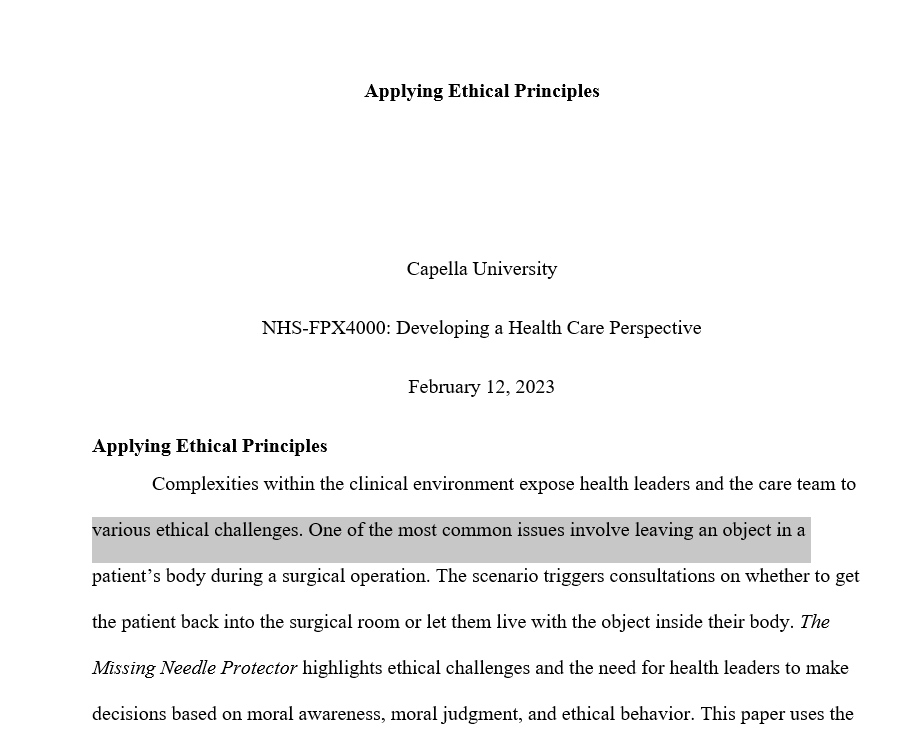Capella University
NHS-FPX4000: Developing a Health Care Perspective
February 12, 2023
Applying Ethical Principles
Complexities within the clinical environment expose health leaders and the care team to various ethical challenges. One of the most common issues involve leaving an object in a patient’s body during a surgical operation. The scenario triggers consultations on whether to get the patient back into the surgical room or let them live with the object inside their body. The Missing Needle Protector highlights ethical challenges and the need for health leaders to make decisions based on moral awareness, moral judgment, and ethical behavior. This paper uses the case to engage readers on the value of making decisions that match clients’ best interests.
Reflection of the Case
Hopewell Hospital significant progress towards improving standards of care resonate with calls for evidence-based and patient-centered practices. The director of clinical services expressed desire to restore the hospital’s competitiveness by making adjustments across the facility (Capella University, n.d). However, complexities in the health sector makes the hospital vulnerable to scenarios that expose patients to complications, additional costs, and other adverse outcomes. The Missing Needle Protector offers an excellent example of errors, largely preventable ones that undermine the quality and safety of patient care. The operating room supervisor acknowledged a mistake that occurred during surgery. The director’s awareness about his roles and responsibilities explains the decision to seek clarification on events leading to the error.
The conversations revealed the need for comprehensive measures, characterized by a robust safety culture that make everyone responsive to ethical principles and standards. The case also highlighted the need for leaders to address power imbalances and hierarchical issues that undermine collective commitment to maintaining a safe clinical environment. For instance, meaningful progress is achievable when physicians or nursing with declining physical and psychological capabilities agree to handle less sensitive procedures. Incidents such as leaving a plastic needle protector from a disposable syringe in a patient’s belly jeopardizes progress made by the director of clinical services towards upholding the best standards of care (Capella University, 2022). The ethical dilemma in the case involves making informed decisions on whether to inform the patient, take her back into the surgical room, or avoid disclosing the details. This way, ethical decisions would require the director of clinical services to examine alternatives and make a decision that reflects commitment to meeting the patient’s best interests.
Ethical Decision-Making Framework
Ethical decisions mean complete knowledge of an issue and interventions necessary to fulfil duty of care to patients. Decisions should portray moral awareness, moral judgment, and ethical behavior (Capella University, 2022). The director responded well to moral awareness, which calls for ability to detect elements of a decision one makes. The director understood the nature of the error and the need for proactive efforts to identify the right solution. Moral judgment is another consideration that allows one to reflect on beliefs and perceptions about the wrong or correct action step (Capella University, 2022). The director’s actions meant that he understood the need to make the right decision after extensive consultations and understanding of the issue. Conversations with the nurse, supervisor, and chief of surgery showed the director’s desire to adhere to the principles of moral judgment.
The third consideration is ethical behavior, characterized by requirement for healthcare professionals to uphold honesty, dignity, and openness. For the director, ethical behavior involved making a decision that would safeguard the patient from severe complications and premature death associated with the error. Adhering to the provisions of the ethical decision-making model strengthens the safety culture, consequently making everyone committed to acting in ways that match a patient’s best interests.
Communication Approaches
The director of clinical services strived to adhere to principles that would allow him to communicate effectively and understand the extent of the problem. Competent leadership entails active listening to allow members of the care team to describe events comprehensively. The leader creates an open and honest environment, where everyone regardless of their position shares insights into the causes of an error and interventions necessary to optimize care outcomes (Alnaser, 2020). Further, acknowledging diversity of thoughts, ideas, and experience allows the leader to make informed conclusions about an issue. Effective communication also means seeking clarification from senior staff (Fischer- Grönlund et al., 2021). The failure to overcome power distances and hierarchical barriers undermine efforts to understand an issue. For instance, the director’s decision to override Cutrite’s evidence limited him from gaining comprehensive details about the events during the operation and interventions necessary to avoid similar scenarios in the future.
Approach used to address the Issue
The ethical principles of beneficence, autonomy, non-maleficence, and justice influence ability to identify the best solution for an ethical dilemma. The case study provides insights into the need for healthcare professionals to understand patients’ interests and pathways for maximizing clinical experience. For instance, beneficence means responding to clients’ best interests (Rizalar & Baltaci, 2020). The director understood that the patient’s best interest involved undergoing a successful operation that would protect her from complications and mortality threats. However, failure to prevent Cutrite from handling sensitive surgical procedures despite physical and psychological limitations undermined the facility’s commitment to delivering services according to the beneficence principle. Autonomy is another important consideration that requires health leaders to allow patients to determine preferred treatment pathways (Rizalar & Baltaci, 2020). The failure to disclose the situation to the patient and seek feedback on preferred pathways undermined the principle of autonomy. The decision also contradicted the need for the care team to uphold justice.
Fairness is a fundamental consideration, which makes health leaders and the rest of the care team responsive to call for personal and professional competence when handling patients. Non-maleficence is another principle, which requires healthcare providers to protect patients’ from emotional, physical, and psychological harm (Rizalar & Baltaci, 2020). The director respond well to the principle by seeking clarifications from relevant parties including the nurse, supervisor, and chief of surgery. The information would enable the director to make an appropriate decision to let the patient live with the object. The director was certain that the decision to avoid returning the patient into the surgical room would not trigger adverse outcomes such as severe complications and premature death.
Conclusion
Ethical dilemmas test the care team’s ability to respond well to moral awareness, moral judgment, and ethical behavior. The Missing Needle Protector demonstrates challenges within the clinical environment that require care consideration of events and decisions that reflect a patient’s best interests. The director’s response to the situation also portrayed the need for health leaders to embrace excellent communication to enable them understand the causes of an error and action steps designed to optimize care outcomes. In this case, transparency, honesty, and openness are elements that promote effective response to dilemmas. However, health leaders should eliminate power gaps and hierarchical barriers that undermine the team’s commitment to improving the quality, safety, and cost of patient care.
References
Alnaser, F. A. (2020). Effective communication skills and patient’s health. CPQ Neurology and Psychology, 3(4), 1-10. https://www.cientperiodique.com/article/CPQNP-3-4-55.pdf
Capella University. (n.d). Ethical case studies: The missing needle protector. Capella University. https://media.capella.edu/CourseMedia/nhs4000element18655/wrapper.asp
Capella University (2022). The ethical decision making model. http://media.capella.edu/CourseMedia/nhs4000element18816/wrapper.asp
Fischer- Grönlund, C., Brännström, M., Zingmark, Z. (2021). The ‘one to five’ method – A tool for ethical communication in groups among healthcare professionals. Nurse Education in Practice, 51, 1-6. https://www.sciencedirect.com/science/article/pii/S1471595321000342
Rizalar, S., & Baltaci, N. (2020). Ethical decision-making levels of nurses and it’s affecting factors. International Journal of Caring Sciences, 13(1), 42-50. https://www.internationaljournalofcaringsciences.org/docs/6_rizarlar_original_13_1.pdf



